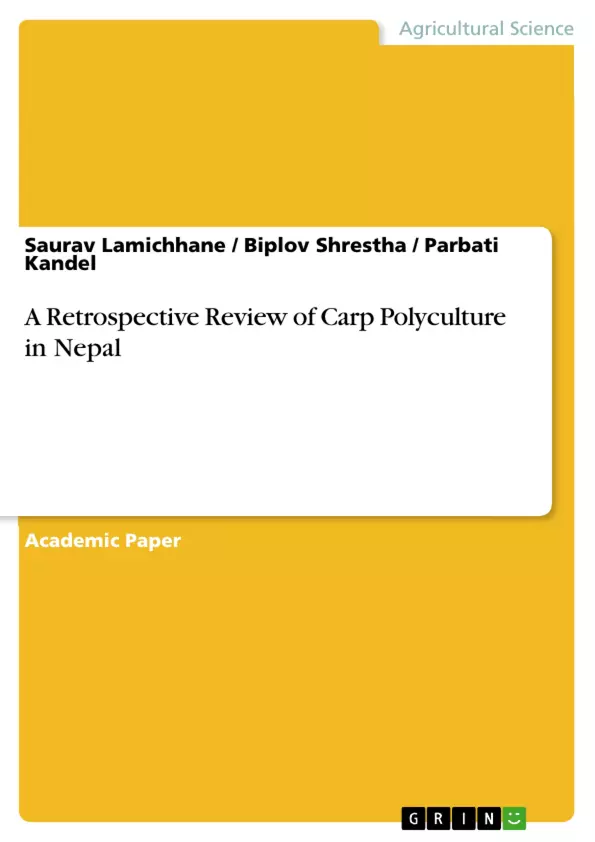This paper is a retrospective review of Carp Polyculture in Nepal. Polyculture is an art and science of growing two or more compatible fish species in a pond to maximize production by taking advantage of different spatial distribution and feeding habits. Polyculture concepts rely on the complete utilization of various spatial niches and trophic of a pond to acquire a maximum production per unit area. Carp polyculture is the most common, popular, and successful aquaculture system in Nepal. Carp polyculture is the major aquaculture system contributing to more than 90% of total aquaculture production in Nepal. In 2018/19, total fish production, aquaculture, and productivity were 91,832 t, 70,832 t, and 4.92 t/ha, respectively, which is insufficient to fulfill the growing demand for fish in Nepal. Therefore, it is essential to increase production and productivity.
Inhaltsverzeichnis (Table of Contents)
- INTRODUCTION
- Carp polyculture
- Principle of carp polyculture
- Principal requirements of different species in combination (Shrestha & Pandit, 2012)
- Pros and cons of carp polyculture
- Pros of polyculture
- Cons of polyculture
- Stocking
- Water quality requirements for carps and Nile tilapia
- Feed and feeding
- Natural food
Zielsetzung und Themenschwerpunkte (Objectives and Key Themes)
This article provides a comprehensive overview of carp polyculture practices in Nepal, highlighting its importance in maximizing fish production. It explores the principles behind this aquaculture system, including species selection, stocking densities, and water quality requirements. The article also examines the pros and cons of carp polyculture, emphasizing its potential for economic benefits and challenges in implementation.
- The importance of carp polyculture in Nepal's aquaculture industry
- The principles and practices of carp polyculture, including species selection and stocking densities
- The environmental factors influencing carp polyculture success, such as water quality and nutrient availability
- The advantages and disadvantages of carp polyculture compared to monoculture systems
- The role of natural and supplementary feeding in carp polyculture
Zusammenfassung der Kapitel (Chapter Summaries)
- INTRODUCTION: This section introduces carp polyculture as a key aquaculture system in Nepal. It describes the concept of polyculture, emphasizing the importance of species compatibility and the use of different ecological niches in maximizing production. The text also highlights the significance of carp polyculture in meeting the increasing demand for fish in Nepal.
- Carp polyculture: This section delves deeper into the concept of carp polyculture, explaining how different fish species with varied feeding habits can be cultured together to optimize resource utilization and minimize competition. It highlights the advantages of polyculture in terms of low investment, high profit, and rapid growth in yield.
- Principle of carp polyculture: This section explores the principles underlying the success of carp polyculture. It discusses how the synergy between different species, particularly in terms of food chain dynamics, can lead to improved environmental conditions and increased food resources. The section provides examples of how different species contribute to each other's well-being within the polyculture system.
- Principal requirements of different species in combination (Shrestha & Pandit, 2012): This section outlines the essential criteria for selecting suitable species combinations for carp polyculture. It emphasizes the importance of complementary feeding habits, different ecological niches, and the ability of species to reach marketable sizes at the same time.
- Pros and cons of carp polyculture: This section presents a balanced perspective on the advantages and disadvantages of carp polyculture. The advantages include improved space and feeding niche utilization, full utilization of natural and formulated feeds, reduced disease problems, and economic diversification. The disadvantages include the need for skilled expertise, difficulty in obtaining fingerlings, and challenges in maintaining a suitable food supply for all species.
- Stocking: This section focuses on the crucial aspect of stocking in carp polyculture. It explains how stocking rates and ratios are determined based on factors such as pond productivity, supplementary feeding, and market demand. The section also discusses the importance of using fingerlings for optimal survival and production.
- Water quality requirements for carps and Nile tilapia: This section emphasizes the importance of water quality in carp production. It presents a table summarizing the acceptable and desirable ranges for various water quality parameters, including temperature, pH, dissolved oxygen, and nutrient levels. The section highlights the critical role of maintaining optimal water quality for successful carp polyculture.
- Feed and feeding: This section addresses the feeding requirements of carp in aquaculture. It distinguishes between natural and supplementary feeds, explaining how natural food sources like phytoplankton, zooplankton, and detritus contribute to fish growth. The section also acknowledges the role of supplementary feeding in meeting the nutritional needs of carp in polyculture systems.
- Natural food: This section delves deeper into the importance of natural food sources in carp polyculture. It highlights the role of phytoplankton as a primary food source and its conversion into zooplankton and ultimately fish meat. The section emphasizes the significance of maintaining a healthy pond ecosystem to provide sufficient natural food for carp growth.
Schlüsselwörter (Keywords)
The main keywords and focus topics of this article are carp, polyculture, aquaculture, fish production, species selection, stocking density, water quality, feed and feeding, natural food, and productivity. The text delves into the technical aspects of carp polyculture, exploring its principles, practices, and impact on fish production in Nepal.
- Arbeit zitieren
- Saurav Lamichhane (Autor:in), Biplov Shrestha (Autor:in), Parbati Kandel (Autor:in), 2021, A Retrospective Review of Carp Polyculture in Nepal, München, GRIN Verlag, https://www.hausarbeiten.de/document/1014217


